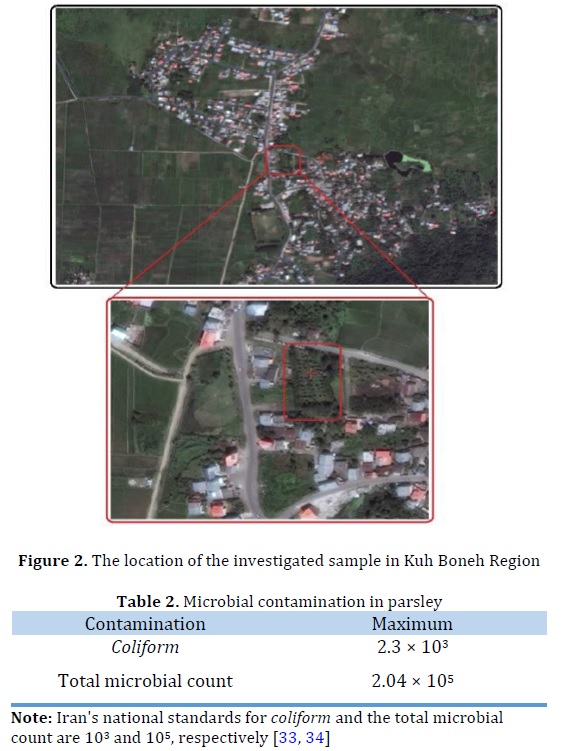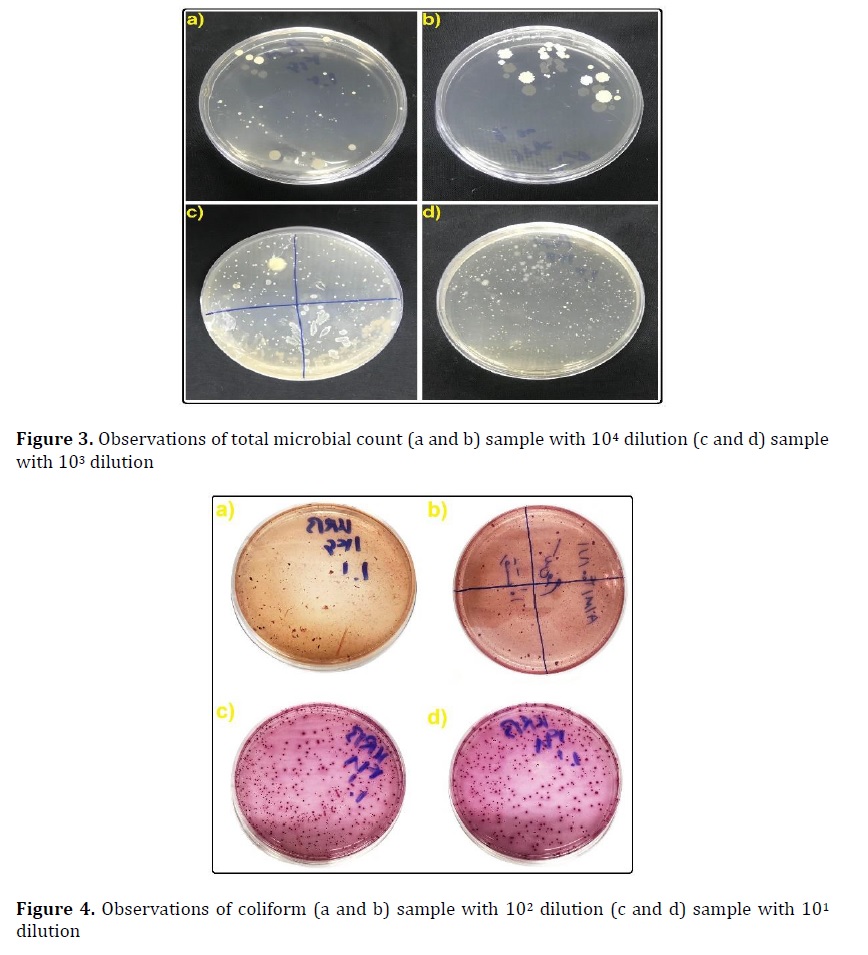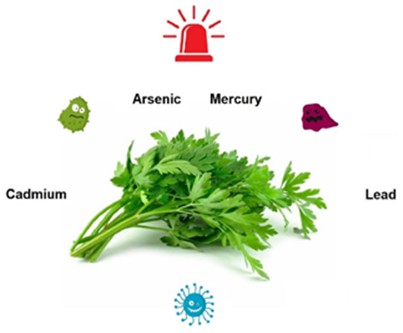Document Type : Original Research Article
Authors
1 Department of Chemical Engineering, Technical Faculty, Lahijan Branch, Islamic Azad University, Lahijan, Iran
2 Faculty of Polymer Engineering, Sahand University of Technology, P.O. Box 51335-1996, Tabriz, Iran
3 Polymer Department, Technical Faculty, South Tehran Branch, Islamic Azad University, Tehran, Iran
Abstract
In this study, microbial contamination included the total microbial count and coliform, as well as the content of toxic metals such as arsenic (As), cadmium (Cd), lead (Pb), and mercury (Hg) in parsley (petroselinum crispum) prepared from local farms in Kuh Boneh Region (Lahijan City, north of Iran) was investigated. The content of toxic metals was evaluated by flame atomic absorption spectrophotometer, and the results showed that content of these metals is lower than the standard level. However, the results of microbial investigation revealed that the samples are contaminated. In fact, the number of colonies was very high and according to the standards, these samples are harmful to health.
Graphical Abstract
Keywords
Main Subjects
Introduction
Environmental pollution is a global problem because as it is a potential hazard to the entire ecosystem [1, 2]. Pollutants caused by industrial waste or anthropogenic sources have caused serious problems for plants, livestock, and humans [3]. According to several criteria such as density, weight, atomic number, and degree of toxicity, metals are classified into categories such as light, heavy, semimetal, toxic, and trace [4]. Meanwhile, there is widespread concern regarding ecosystem pollution due to toxic metals. They come from various sources such as natural sources (parent rocks and metallic minerals), anthropogenic sources including agriculture (fertilizers and pesticides), metallurgy (mining, smelting, and metal finishing), energy production (leaded gasoline, battery production, power plants), microelectronics, plastic, sewage sludge, and scrap disposal [5-18]. According to the international agency for research on cancer in 2010, As and Cd are group I human carcinogens, and also As is the second leading cause of water-related deaths in the world [19-22]. Research has revealed that high levels of toxic metals such as As and Cd are associated with a higher risk of cancers of the bladder, kidney, liver, lung, and skin [23]. On the other hand, bacteria and fungi, which are also known as pathogens, are harmful to human health [24-30].
Herein, the microbial contamination and concentration of heavy metals such as Pb, As, Hg, and Cd in parsley prepared from Kuh Boneh region (Lahijan City, north of Iran) were investigated.
Experimental
Materials and Methods
The samples (parsley) were gathered from the Kuh Boneh Region (Figure 1) in Lahijan (north of Iran). Nitric acid (65%), hydrochloric acid (37%), hydrogen peroxide (30%), potassium chloride, and all other solvents and chemicals were purchased from Merck Chemicals Co. (Germany) and used as received.
Preparation, measurements, and analysis of samples
Digestion and statistical analysis of samples were performed according to the procedure which was described in the literature [31, 32]. Briefly, nitric acid, hydrochloric acid, hydrogen peroxide, and potassium chloride were used for digestion, and deionized water for dilution. The samples (200 mg) were used in digestion vessels (containing 10 mL of HNO3 and 12 mL of H2O2), and then the volume of each solution reached 50 mL using deionized water. The concentrations of heavy metals were investigated on an atomic absorption spectrophotometer (ICE 3300, Thermo Scientific). Likewise, microbial contamination (total microbial count and coliform) were performed according to the procedure which was described in the literature and Iran's national standard [33, 34]. Moreover, Equation 1 was used to calculate microbial contamination [33, 34].

Where, ΣC, V, N, n, and d are the total number of microorganisms in the plate, the volume used of the desired dilution, the number of primary dilution plates, the number of higher dilution plates, and the initial dilution exponent, respectively.
Results and Discussion
Table 1 presents the assessment results of toxic metals in parsley. The results show that the amounts of toxic metals are lower than the standard level. Plants absorb metal ions from the soil by their roots, and humans and livestock absorb them by consuming plants. For example, Pb and Cd are significantly absorbed by internal organs such as the intestine and conveyed to other tissues such as the liver, kidneys, and bones [35, 36]. Cd has harmful effects on human lung function and the reproductive system [37]. Furthermore, Hg toxicity can cause coronary heart disease, myocardial infarction, carotid artery occlusion, and atherosclerosis [38].

Moreover, As can cause bronchitis, laryngitis, lung cancer, and liver cancer. In fact, it can be mentioned that the low amount of toxic metals is due to the distance of this region (Kuh Boneh) from Lahijan City and the main road (See Figures 2 and 3), and also there is no industry that causes pollution.
In addition to the assessment of toxic metals, microbial contamination (total microbial count and coliform) was investigated, the results of which can be seen in Table 2 and Figures 3 and 4. As can be seen, the number of colony is very high, which are unacceptable according to Iran's national standards (standards 9263 and 5272, which are related to coliform and total microbial count, respectively) [33, 34].


Normally, vegetables can be a source of bacteria contamination in most cases due to the lack of proper disinfection. The presence and number of microorganisms are variable and depend on factors such as the type of product, agricultural activities, geographical area, and weather conditions [40]. Many factors can cause the contamination of vegetables, such as soil, water, feces, pesticides, insects, and animals [41]. Although washing vegetables is an important way to reduce pathogens, some factors such as the presence of pathogens inside the plant tissue, the biofilm formation by bacteria, and the hydrophobicity of plant surface limit its effectiveness. Prevention of contamination of vegetables should be observed in all activities before, during, and after harvesting, and also proper training of farmers to not use too much fertilizer and to use safe water is very necessary.
Conclusion
To sum up, the amount of toxic metals and microbial contamination in parsley (petroselinum crispum) prepared from local farms in the Kuh Boneh Region was investigated. The results revealed that the levels of toxic metals are low. However, the results of microbial evaluation revealed that the samples are contaminated. This study showed that vegetables should be continuously investigated.
Disclosure Statement
No potential conflict of interest was reported by the authors.
Funding
This research did not receive any specific grant from funding agencies in the public, commercial, or not-for-profit sectors.
Authors' contributions
All authors contributed to data analysis, drafting, and revising of the paper and agreed to be responsible for all the aspects of this work.
Orcid
Pegah Ghiasvandnia
https://orcid.org/0000-0002-5653-4744
Milad Sheydaei
https://orcid.org/0000-0002-2013-1871
Milad Edraki
https://orcid.org/0000-0001-6784-875X
How to cite this manuscript: Pegah Ghiasvandnia, Milad Sheydaei*, Milad Edraki. Evaluation of microbial contamination and toxic metals content of parsley (Petroselinum Crispum) obtained in kuh boneh regio (Lahijan City, North of Iran). Asian Journal of Green Chemistry, 7(1) 2023, 17-24. DOI: 10.22034/ajgc.2023.1.3


